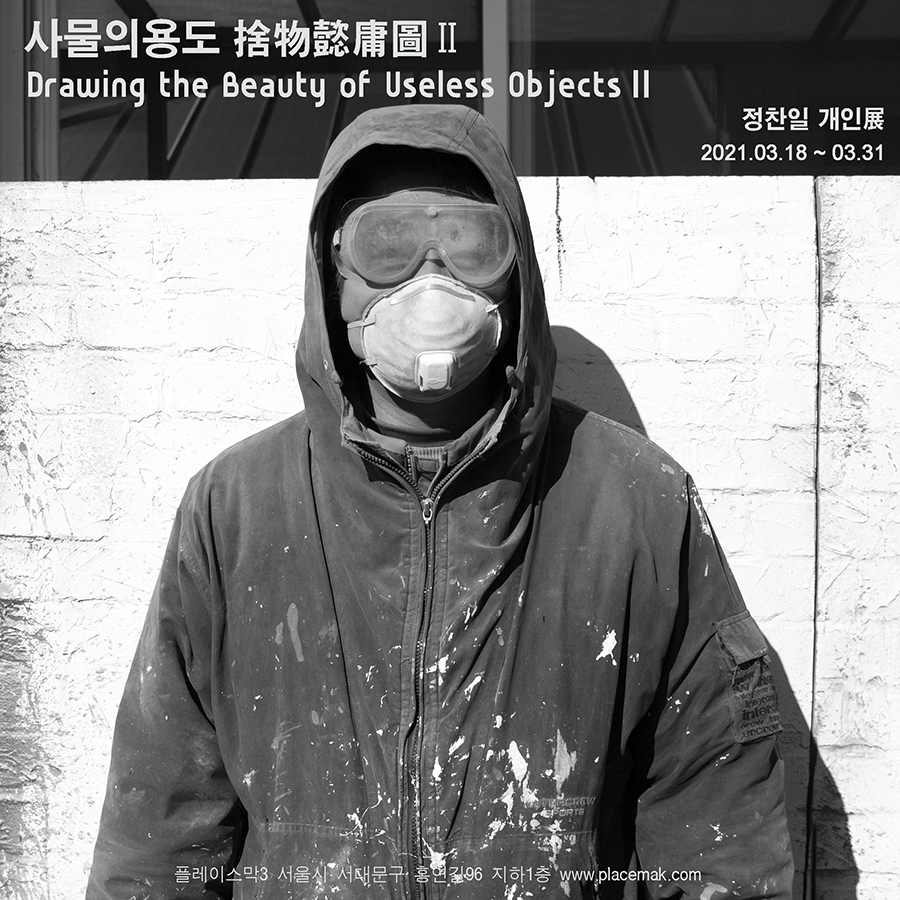
용도用度를 넘어 용도庸圖로 나아감
수집은 정찬일의 작업에서 큰 부분을 차지했다. 10년 동안 자신이 머물렀던 동네에서 그는 버려진 나무상자나 가구 등을 주웠다. 그래서 수집 장소는 주로 작업실이 있던 서울 연희동 주변이지만, 예술가 레지던시에 참여했던 제주도와 공주시 유구읍에서도 폐목재를 모았다. 그리고 폐목재는 새로운 가구가 되어 정찬일의 개인전 『사물의용도 捨物懿庸圖Ⅱ』를 위한 작품이 되었다. 전시된 가구가 작품이니 가구의 재료, 형식, 내용 등을 분석해야 할 것 같다. 그러나 가구의 예술성을 논한다면 이번 전시를 온전히 이해할 수 없다. 줍기-손질하기-만들기-칠하기라는 과정 전체를 하나의 작품으로 보고 행위 하나하나가 갖는 의미를 찾는 것이 타당하다.
전시 구성은 이러한 의견을 뒷받침해준다. 전시장 바닥에는 가구가 놓였고, 벽에는 도면, 손질한 목재를 모아놓은 사진, 폐목재를 주워온 장소 사진 등이 걸렸다. 장소 사진은 줍기, 목재 사진은 손질하기, 도면과 가구는 만들기와 칠하기의 행위와 관련이 있다. 가구뿐만이 아니라 가구의 제작 과정을 파악하도록 돕는 부차 자료로 여겨질 수 있는 도면과 사진도 작품의 일부다. 도면과 사진은 행위와 관련해 여러 층위에서 이번 작업을 이해해야 함을 보여주기 때문이다. 따라서 이 글에서는 전시장에 놓여있거나 걸려있는 대상이 아닌 각각의 행위를 중심으로 그것이 갖는 의미를 살펴보고자 한다.
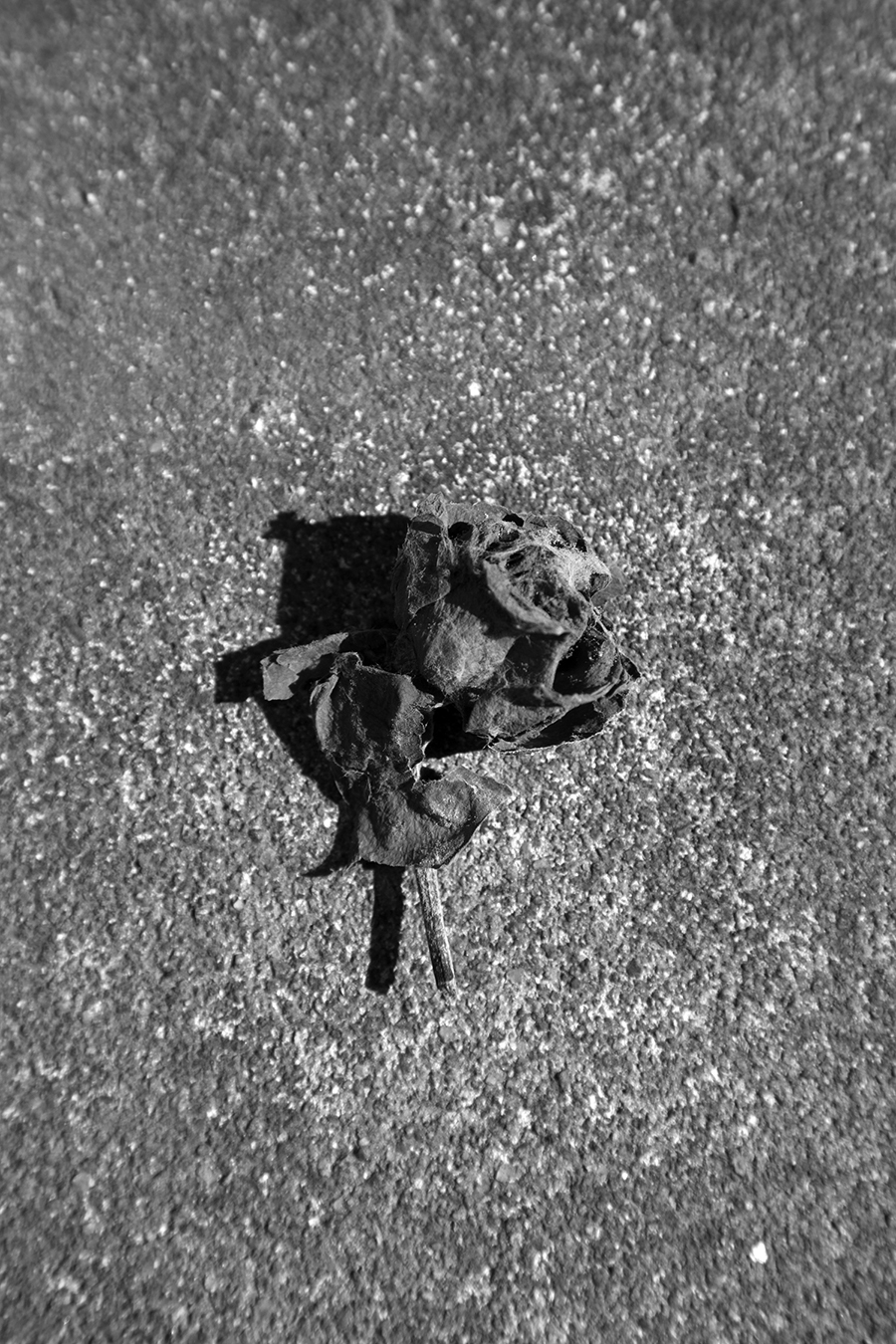
길-연희동 작업실 곰팡이꽃_디지털 프린트_가변크기_2013
수집가는 보통 수석이나 우표 수집처럼 순수한 즐거움, 보존하고자 하는 소명 의식 등으로 무엇인가를 수집한다. 집요함, 지속성 등 태도에 있어서는 일반 수집가와 정찬일이 유사하다. 그러나 수집 목적은 사뭇 다르다. 그는 사용할 가구를 만들기 위해 폐목재를 수집했다. 수집 대상 그 자체를 목적으로 하지 않고, 그것을 넘어선 다른 무언가를 위한 수집이다. 그래서 그의 수집은 취미 활동이 아닌 예술 행위가 된다. ‘필요’라는 겉으로 드러나는 가구 제작의 목적도 일종의 핑계일 뿐이다.
버려진 목재를 줍는 행위는 사회 문제에 직접 참여하는 작가의 실천 행위다. 자본주의의 폐해가 한두 가지는 아니지만, 그 중 자연환경 파괴도 심각하다. 대량생산된 상품은 필요하지 않아도 구매되고, 쉽게 버려진다. 정찬일의 수집이라는 행위는 가구 제작이라는 목적에 종속되지 않고, 자본주의의 미덕인 소비가 지구에는 재앙임을 선언하는 역할을 한다. 그의 실천은 작업의 모든 과정에서 철저하고, 일관되게 유지되었다. 남이 버린 것을 모아 다시 사용했을 뿐 아니라 스스로 쓰레기를 만들지도 않았다. 상자였던 종이에 도면을 그렸고, 쓰고 남은 먹물로 가구를 칠했으며, 나사를 사용해 목재를 조립했다. 못을 사용하면 목재를 다시 사용할 수 없기 때문이다. 이러한 개인의 실천이 환경 문제를 해결하지는 못한다. 그러나 그의 전시는 우리에게 환경 문제를 환기하며 고민하게 만든다.
수집 뒤에는 또 하나의 숨겨진 행위가 있다. 바로 관찰이다. 골목을 걸어 다니며 버려진 목재를 주울 때 그곳을 사진으로 기록했다. 사진과 영상작업을 해온 그에게는 자연스러운 일이다. 사진은 폐목재가 있었던 장소의 증명사진이다. 또한, 도시의 변천을 기록한 기록물이다. 10년간 찍어왔기 때문이다. 실제로 강산이 변했다. 낮은 아파트가 무너지고 고층 아파트가 들어섰다. 사진 속에는 자본의 흐름에 따라 변해가는 장소의 역사가 담겼다.
사회 문제를 제기하는 수집과 달리, 폐목재 손질은 예술이란 무엇인지를 다시 생각하게 한다. 개념미술이 주를 이루는 현대 미술에서는 작가 자신의 손으로 작품을 제작하는 것이 중요하지 않다. 그러나 정찬일은 고집스럽게 목재를 직접 손질하고 가구를 만들었다. 심지어 대부분 전동 기계의 힘을 빌리지 않고 자신의 힘을 사용해 작업했다. 나무에 박힌 불필요한 못은 장도리로 뽑고, 톱으로 나무를 잘랐다. 산업혁명으로 기계에 의해 똑같은 물건이 대량생산되자, 수공예로 돌아가자고 외쳤던 존 러스킨과 윌리엄 모리스의 미술공예운동은 19세기의 일이다. 동시대 미술을 이야기하는 오늘날 수작업이 무슨 의미가 있단 말인가? 그러나 그에게는 이것이야말로 예술 행위다. 수작업을 할 수밖에 없었던 옛날과 달리 지금은 수작업이야말로 작가의 의지로 행해지기 때문이다.
가구는 도면에 따라 제작되었다. 그러나 가구 제작에 있어서 작가의 계획보다 더 중요하게 작용한 요소가 있다. 바로 폐목재 자체의 크기와 형태다. 필요에 맞춰 구입하지 않고 수종, 크기, 형태가 정해져 있는 폐목재를 주워왔기 때문이다. 그래서 정찬일의 가구에는 주웠을 때 박혀있던 못 자국이 남아있고, 색이 균질하게 칠해지지 않았으며, 판재 두 개가 이어져 하나의 장식장 상판이 되었다. 예술가란 창조자로 신과 같은 존재라고 여겨진다. 그러나 그는 자신의 상상력을 주어진 조건에 맞춰 제한했다. 대신 예술가가 아무리 창조자여도 만들어낼 수 없는 지난 시간을 가구에 담을 수 있었다. 가구에 남아있는 흔적은 폐목재의 과거다. 못 자국, 얼룩 등은 버려지기 전 나무가 무엇이었을지 유추하게 만든다.
마지막 칠하기 과정은 우선 버리지 않는다는 실천의 연장이다. 오랜 시간 보관해온 남은 먹물로 가구를 칠했다. 동시에 예술이 무엇인가라는 질문을 던진다. 먹물을 칠하는 과정은 나무 고유의 특성과 폐목재에 새겨진, 사용되었던 흔적을 덮는 행위이다. 그러나 흔적은 먹물 위를 비집고 나와서 폐목재가 용도用度가 있던 사물私物이었음을 알게 한다. 이렇듯 창작자의 의도를 무력하게 만들고, 자신의 과거를 드러내는 사물의 힘이 사물을 예술로 이끈다.
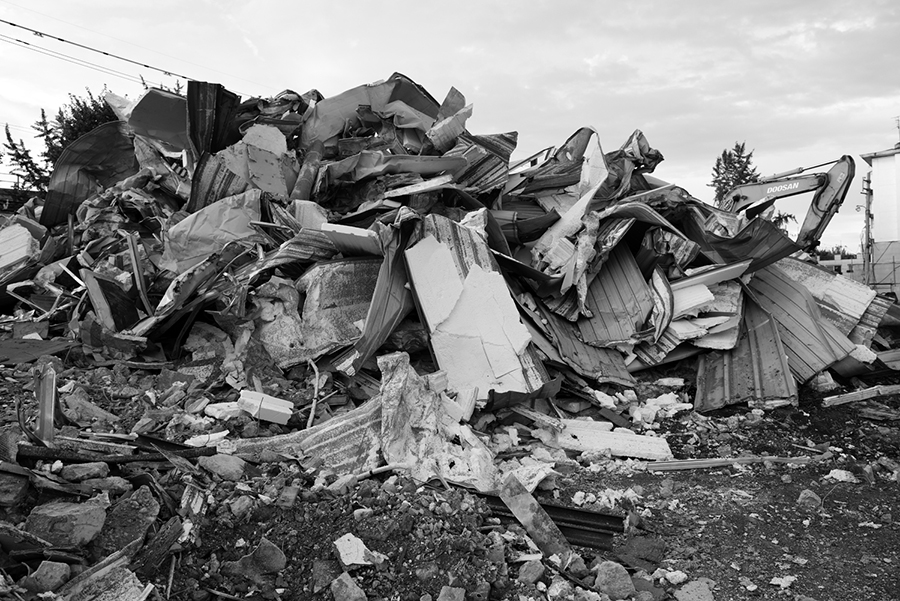
나무가 온 곳-작업실 근처-연희동-홍연 아파트-철거-재건축_디지털 프린트_가변크기_2016
2013년 제주도에서 개인전 『사물의용도 捨物懿庸圖』가 이미 열렸다. 폐목재를 재활용한다는 점은 이번 전시와 같으나, 『사물의용도 捨物懿庸圖』에서는 한 사람을 위한 맞춤형 가구를 제작했다. 제주도 전시는 기성품이 주는 불편함을 깨닫게 함으로써, 불편함을 불편하다고 깨닫지 못하게 하는 사회 구조를 드러내고자 했다. 『사물의용도 捨物懿庸圖Ⅱ』는 의미하는 바가 더 복잡해지고, 깊어졌다.
한결같던 행위 ‘줍고 있다’는 이제 현재진행형이 아닌 ‘주웠다’라는 과거형이자 ‘주울 것이다’라는 미래형이 되었다. 정찬일은 이번 전시로 행위의 일단락을 알렸다. 행위가 멈추자 행위의 의미가 드러났다. 용도가 폐기된 나무를 주워 가구라는 새로운 용도를 부여하는 그의 행위는 사회 문제와 예술 의미를 다시 생각하고, 고민의 결과를 따르는 실천이었다. 전시가 끝난 뒤, 작가가 보여준 행위, 즉 반성과 실천이 우리에게 이어져 멈추지 않고 지속되길 바란다.
김연주(문화공간 양 기획자)
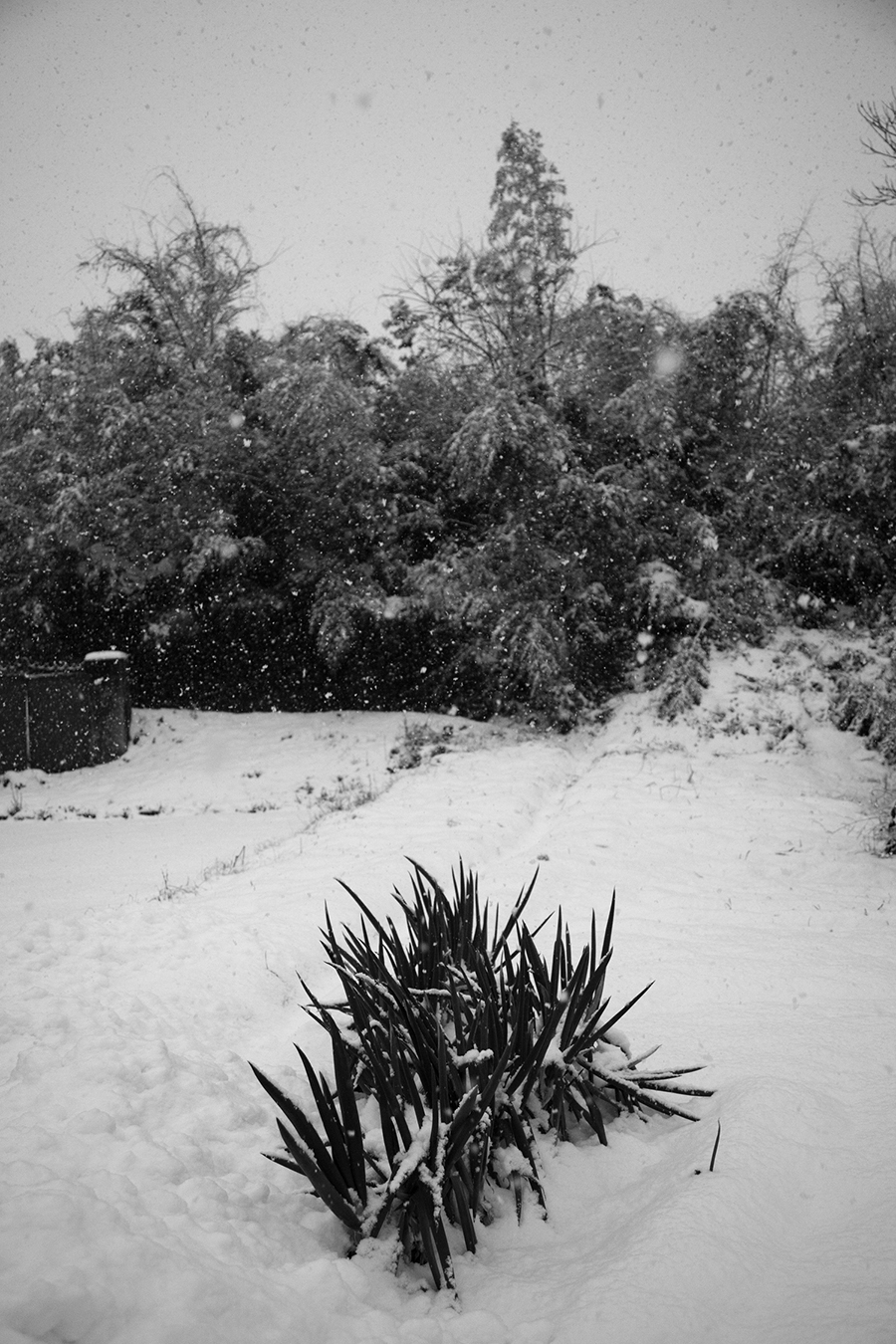
나무가 온 곳-유구-눈 많이 오는 날 도서관 가는 길 조그만 파밭_디지털 프린트_가변크기_2014
Beyond the Use of Objects Toward the Work of Art
The collection was a big part of Chan-il Chung's work. He picked up abandoned wooden boxes and furniture in the neighborhood where he had stayed for ten years. Therefore, his collection place was mainly around Yeonhui-dong, Seoul, where the location of his art studio. In addition, the collection of waste wood continued in Yugu-eup, Gongju City, and Jeju-do, where he participated in the artist-in-residence program. As a result, waste wood became a new piece of furniture, and it became the work for Chan-il Chung's solo exhibition, 『Drawing the Beauty of Discarded Objects Ⅱ』. Since the exhibited furniture is a work of art, it seems necessary to analyze the materials, forms, and contents. However, if we discuss the artistry of furniture, we cannot fully understand this exhibition. It is reasonable to look at the entire process of picking up, trimming, making, and painting as a piece of work and finding each action's meaning.
The composition of the exhibition supports this opinion. Furniture was on the floor of the exhibition hall. Furniture design drawings, photographs of trimmed waste wood, and photographs of the place where the waste wood was picked up were hung on the wall. Place photographs mean picking up, wood photographs represent trimming, and furniture design drawings and furniture are related to the act of making and painting. Furniture design drawings and photographs, which can be considered secondary data to help identify furniture and furniture manufacturing processes, are part of the work. These are because the furniture design drawings and photographs show that these works need to be understood on several levels about the act. Therefore, in this article, I would like to examine the meaning of each action, not the objects placed or hung in the exhibition hall.
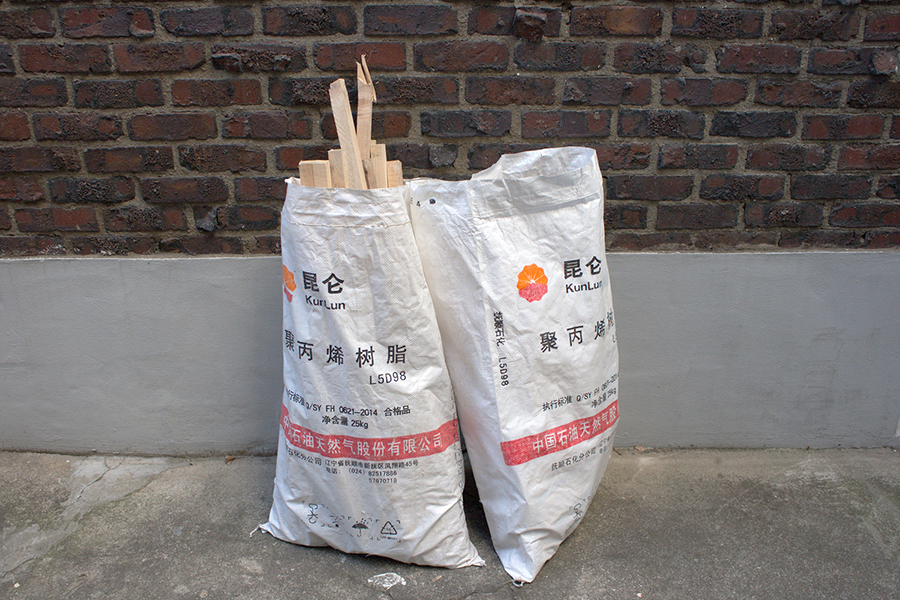
2015년 12월말 후암동 영주교회 근처 노동하던 곳에서 모아온 나무_디지털프린트_가변크기_2015
Collectors usually collect something with pure enjoyment, a sense of vocation to preserve, like collecting stones or stamps. Chan-il Chung is similar to a general collector in attitudes such as his persistence and continuity. However, the purpose of his collection is quite different. He collected waste wood to make furniture for use. His collection is not for the collection itself but for something else beyond that. Thus, his collection becomes an act of art, not a hobby. The purpose of making the furniture, which he mentioned as 'need,' is just an excuse.
The act of picking up discarded wood is the artist's practice of directly solving social problems. There are many harmful effects of capitalism, but the destruction of the natural environment is also severe. Mass-produced products are purchased and easily discarded even if they are not needed. Chan-il Chung's act of collection is not subordinate to the purpose of making furniture but rather to declare that consumption, the virtue of capitalism, is a disaster for the planet. His practice was kept thorough and consistent throughout the entire process of his work. He not only collected and reused what others had discarded, but he also did not make trash on his own. He drew furniture design drawings on paper that used to be a box, painted furniture with leftover Chinese ink, and assembled wood using screws. The reason is that wood cannot be used again if nails are used. These individual practices do not solve environmental problems. However, his exhibition reminds us of environmental issues and makes us think.
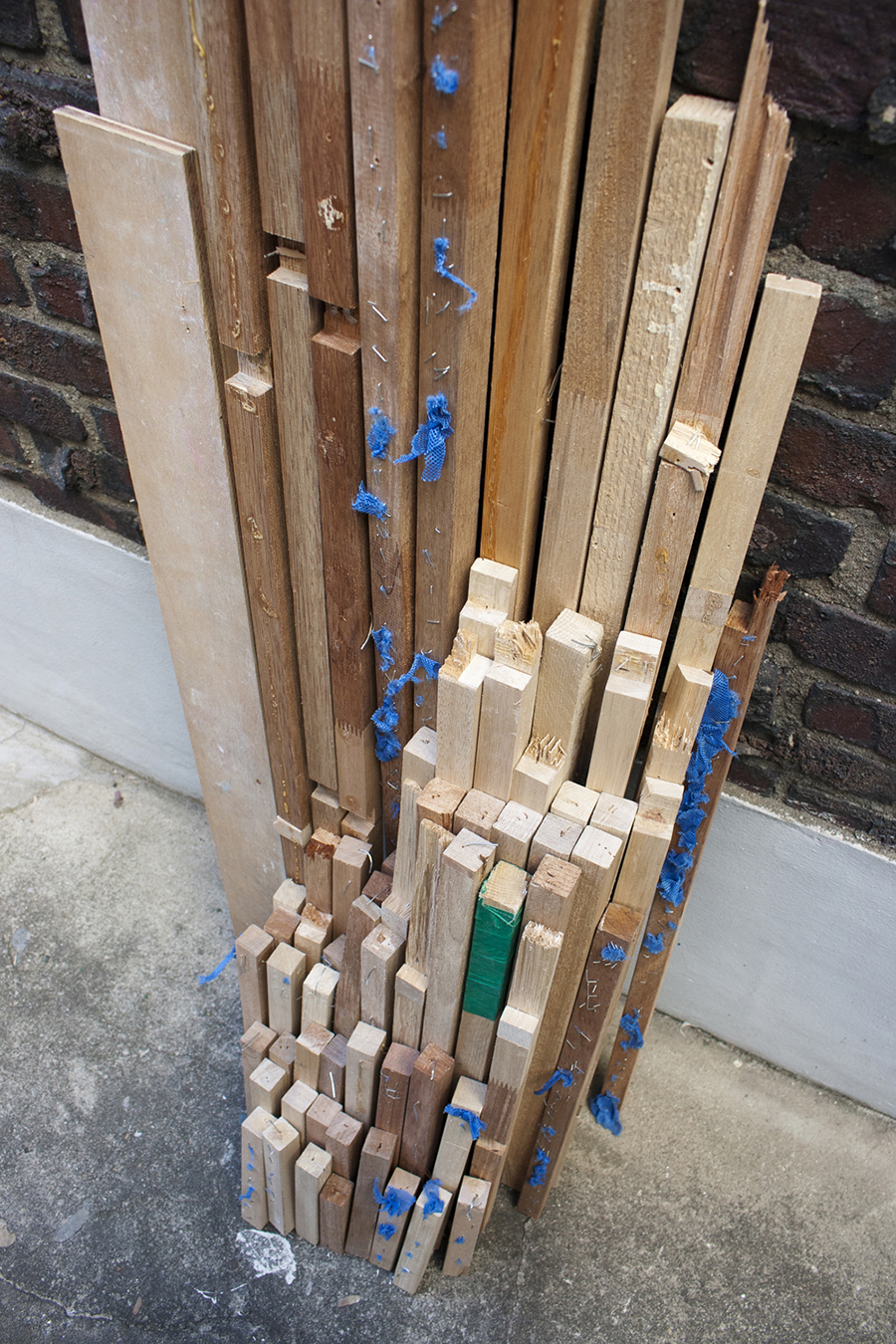
아는 작가 작업실에서 가져온 나무_디지털 프린트_가변크기_2016
There is another hidden act behind the collection. That is a record. When Chan-il Chung walked around the alley and picked up discarded wood, he recorded the place as photographs. Records are natural for him, who has been working on photography and video. The photograph is an identification picture of the place where the waste wood was located. In addition, it is the record of the changes in the city. That is because he has filmed for ten years. Indeed, the landscape has changed in the meantime. Low apartments collapsed, and high-rise apartments were built. The photograph contains the history of the place that changes with the flow of capital.
Unlike the collection, which raises social issues, trimming waste wood makes us rethink what art is. In contemporary art, where conceptual art is dominant, creating works with the artist's own hands is not essential. However, Chan-il Chung stubbornly trimmed waste wood himself and made furniture. He even worked with his own hands, mainly without the power of electric tools. Unnecessary nails stuck in the wood were pulled out with a claw hammer and cut down the wood with a saw. The Arts and Crafts Movement of John Ruskin and William Morris, who called for the return to handicrafts when machines mass-produced the same objects due to the Industrial Revolution, dates back to the nineteenth century. Today we are talking about contemporary art. Is handwork meaningful? However, this is an act of art for him. The reason is that, unlike in the past, when there was no choice but manual work, manual work is done at the artist's will nowadays.
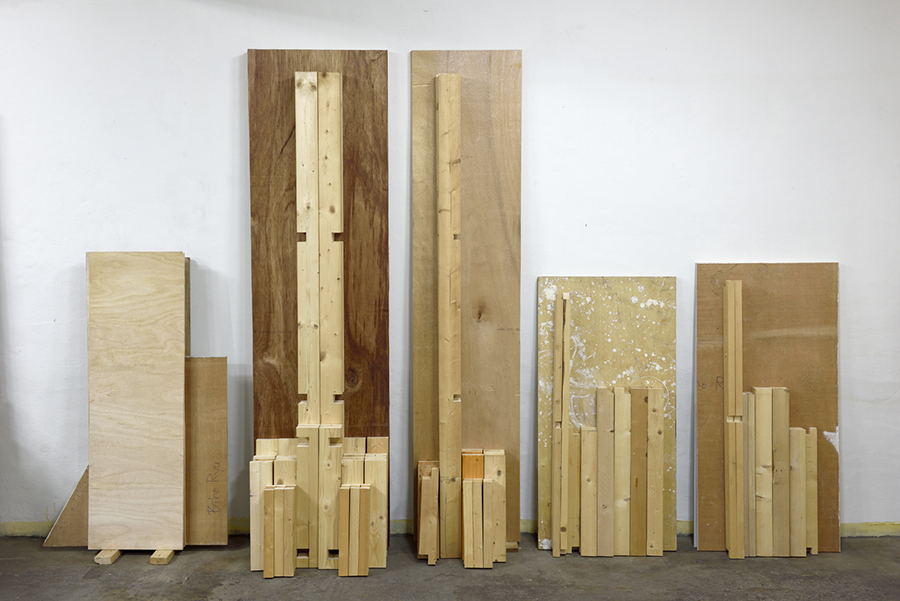
연희동 작업실-내가 쓸 물건-새로 이사 온 홍은동 집에 쓸 물건재료_디지털 프린트_가변크기_2020
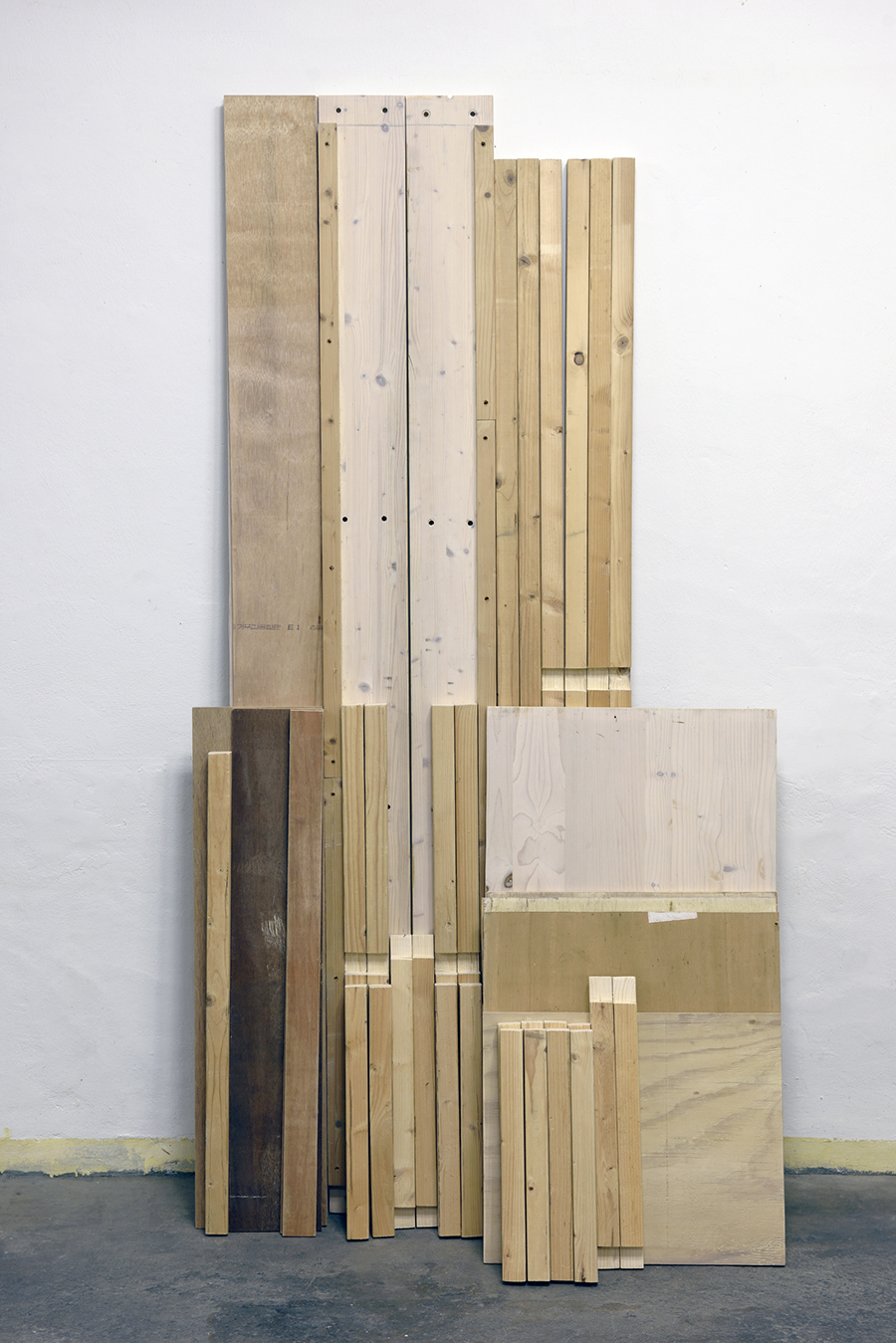
내가 쓸 물건-문 없는 장_디지털 프린트_가변크기_2020
Furniture was made according to furniture design drawings. However, there is an element that worked more importantly than the artist's plan in making furniture. It is the size and shape of the waste wood itself. The artist picked up waste wood with fixed tree types, sizes, and forms rather than purchasing the wood according to his needs. Therefore, on the furniture made by Chan-il Chung, the nail marks that were stuck when picked up remained, the color was not painted evenly, and two pieces of wooden boards were joined together to form one shelf top. The artist is considered a god-like being as a creator. However, he limited his imagination to the conditions given. Instead, he could put the past time into furniture that no artist can make, no matter how much the artist is a creator. The traces left on the furniture are the past of waste wood. The traces on the wood, such as nail marks and stains, make an analogy of what the wood was before it was thrown away.
It is an extension of the practice of not throwing away the last painting process. The furniture was painted with leftover Chinese ink that had been stored for a long time. At the same time, the question is what art is. The process of painting Chinese ink covers up the unique characteristics of wood and the traces of use engraved on the waste wood. However, the traces come out over the ink, revealing that the waste wood was an object that had a purpose. In this way, the power of the object that makes the creator's intention powerless and reveals his past leads the object into art.
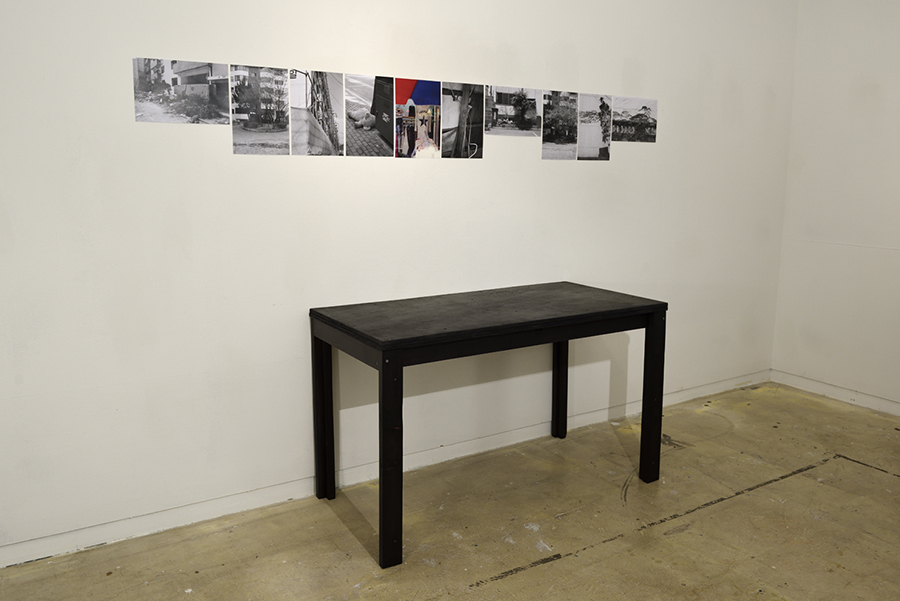
사물의 용도 Ⅱ_전시 설치장면_2021
In 2013, Chan-il Chung's solo exhibition 『Drawing the Beauty of Discarded Objects I』 was already held in Jeju-do. It is the same as this exhibition in that the waste wood is recycled, but in 『Drawing the Beauty of Discarded Objects I』, customized furniture was produced for one person. The exhibition on Jeju-do aimed to reveal a social structure that prevented people from realizing the discomfort as uncomfortable by making them aware of the discomfort of ready-made products. Therefore, the meaning of 『Drawing the Beauty of Discarded Objects II』 has become more complex and profound.
The consistent act of 'pick up' is now the past tense of 'picked up' rather than the present progressive form, and the future tense of 'will pick up.' Chan-il Chung announced the end of the act with this exhibition. When the act was stopped, the meaning of the act was revealed. His act of picking up discarded wood and giving it a new purpose as furniture reflected rethinking social issues and the meaning of art and was a practice that followed the results of deep thought. After the exhibition, I hope that the artist's action, this is, the reflection and practice, will continue to us without stopping.
Kim, Younjoo(Curator)
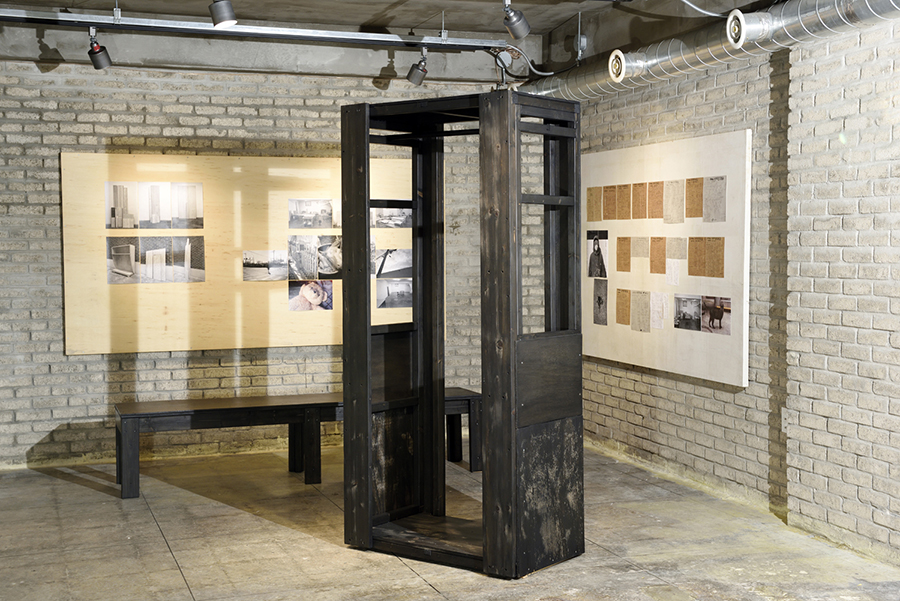
사물의 용도 Ⅱ_전시 설치장면_2021
용도를 다한 버려진 사물들의 아름다움 그리기
20세기 초부터 대량생산의 산업화와 함께 미술작품 재료라고 명명하기 힘든 버려지거나 폐기된 물건들이 현대미술의 오브제로 등장하며 예술가들의 작업 영역을 확장시켰다. 마르셀 뒤샹의 자전거 바퀴, 로버트 라우센버그의 컴바인 작업, 그리고 존 체임벌린의 자동차 고철을 이용한 조각 등 산업화 과정에 버려지고 폐기된 사물들은 예술의 영역을 ‘고귀하고 우아한 작품’에서 벗어나, 자본주의 발달에 따른 현대인의 삶과 연결된 ‘사회와 시대상을 반영하는 예술작품’으로 재현되었고, 예술가들은 비판적 사고를 담으며 사회변화에 동참해 왔다. 21세기 대한민국의 동시대미술에서도 여전히 지속되고 있는 이러한 작업들이 갖는 시각예술의 위치와 의미를 좀 더 들여다 볼 필요가 있다.
정찬일의 『사물의용도 捨物懿庸圖 II』 전시는 버려진 물건들과 폐목들을 모아 다시 사용할 수 있는 사물로 재탄생시키는 과정을 미학적으로 서술하였다. 작가는 작업의 출발점이 친환경 마케팅 개념 뒤에 숨어 대량으로 나무를 베어 제품을 만들고 물건을 함부로 버리는 행위에 대한 반감에서 시작되었다고 한다. 굳이 전 지구적으로 겪고 있는 환경문제라는 거대담론을 언급하지 않더라도 일상에 흔히 존재하는 버려진 사물에 주목함으로써 대중들에게 생활 속에 만연한 현실의 문제를 함께 고민하는 화두를 던진 것이다. 모든 사물들은 탄생에서 소멸까지 여러 인연들을 거치며 그들만의 시공간적 역사성을 갖는다. 작가가 선택한 이러한 버려진 사물들과 폐목들이 작가의 노동 행위를 통해 해체되고 다시 형상을 갖추어 나가는 과정과 그것과 연결되어 기록한 사진 이미지들은 작업의 또 다른 오브제라 할 수 있다. 즉, 결과물로 보여 지는 전시장의 작품은 가구가 아닌 버려진 먹물로 색을 입히고 바니쉬로 마감한 오브제이며, 그것이 전시장에 놓이는 순간 ‘수명을 다해 버려진 사물들’에 메시지를 담고 아름다움을 입혀 다양한 방식으로 설치한 3차원적 공간 드로잉이 된다.
이러한 작업들이 시각언어로 표현될 때, 미술은 대중의 마음을 움직이며 일상에 당면한 문제들을 환기시킨다. 미술이 정치, 경제, 사회적 언어를 어떻게 시각화하여 풀어내는 지 보여주는 것이다. 사회문제의 메시지를 담은 단 한 점의 예술작품은 백 마디의 사회적 언어보다 이해하기 쉬운 강렬한 이미지로 대중을 설득시킨다. 예술가의 손을 거친 시각예술이 보여주는 언어는 사회구성원 개개인이 고민하던 문제의식을 열어 소통의 창구를 마련하고 보이지 않는 공론의 장을 펼치는 것이다. 이 공론의 장이란 문제의식을 담아 보여주는 시각예술의 이미지에 반응하고 그 시각언어가 전달하는 메시지에 공감하는 대중들의 사회적 반향과 실천적 행동이라 하겠다. 대중들의 능동적 참여와 실행이 예술을 통한 사회화 과정과 맥을 같이 하는 것이다.
예술은 사회에서 이처럼 하나의 역할을 하고 있다. 예술의 역할은 가장 기본적으로 사회구성원들에게 아름다움이 있다는 것을 깨닫게 하고 감동을 전달하는 것이다. 예술은 어떤 과학과 기술로도 드러낼 수 없는 것을 대중에게 보여줄 수 있기 때문이다. 또한 사회 안에 존재하는 그 사회의 감정과 갈등을 표현하고 나아가 사회가 대처하고 극복할 수 있도록 영감을 주는 것이다. 예술은 더 깊은 차원에서 사회 내의 중요한 가치를 대중들에게 기억에 남는 방식으로 표현할 수 있으며, 현실에 대한 더 깊은 이해를 얻기 위한 인간의 노력을 강력하게 촉발시킬 수 있다.
버려진 사물에 대한 시대적 인식과 가치를 미학적으로 구현하고 소통하는 작업은 21세기에도 진행 중이다. 자본주의 시대의 생산과 소비가 과포화 된 상황에서 인간의 욕망에 따른 책임을 묻지 않을 수 없다. 1년이 넘게 지속되고 있는 코로나19 바이러스의 대유행으로 그 어느 때 보다 일회용품의 남용이 만연한 만큼, 이제는 환경에 대한 대중적 인식과 실천이 절실한 시점이다. 예술이 사회라는 테두리 안에서 현실공간이 되어 그 존재감을 발휘하고 소통하는 이유이다.
정수은(독립큐레이터)
Drawing the Beauty of Discarded Objects that Have Exhausted Their Uses
Along with the industrialization of mass production from the early 20th century, abandoned or discarded objects, which were hard to name as art materials, emerged as objects of contemporary art, expanding the scope of artists' works. The objects abandoned and discarded in the industrialization process, such as Marcel Duchamp's Bicycle Wheel, Robert Rauschenberg's series of Combines, and John Chamberlain's sculpture using scrapped metal from automobile bodies, escaped the realm of art from 'noble and elegant works.' Moreover, it was reproduced as 'works that reflect society and the times' connected to modern people's lives in the development of capitalism. Thus, artists participated in social change by combing critical thinking into their works. Therefore, it is necessary to look into the position and meaning of visual arts of these works, which are continuing in contemporary Korean art in the 21st century.
The exhibition of 『Drawing the Beauty of Discarded Objects II』 by Chan-il Chung aesthetically depicts the process of collecting discarded objects and waste wood and re-creating them into reusable objects. The artist said that his antipathy to the act of cutting down trees in large quantities and throwing things away quickly, hiding behind the concept of eco-friendly marketing, became the starting point of his work. Even without mentioning the enormous discourse on environmental issues that are experiencing globally, he focused on abandoned objects that are commonly seen in everyday life, raising the topic of considering the problems of reality that are prevalent in daily life. All objects go through various ties from birth to extinction and have their temporal and spatial historicity. The process by which these discarded objects and waste wood chosen by the artist are dismantled and re-formed through the artist's labor activities and the photographic images recorded in connection with them are another object of his work. In other words, the works in the exhibition hall shown as results are not furniture, but objects painted with discarded ink and finished with varnish. The moment these objects are placed in the exhibition hall, these become three-dimensional spatial drawings, installed in various ways by putting messages on 'discarded objects' and applying beauty.
When these works are expressed in visual language, art moves the public's mind and evokes the problems faced by everyday life. It shows how art visualizes and unravels political, economic, and social languages. A single piece of artwork containing a message of social issues persuades the public with an intense image that is easier to understand than a hundred words of social language. The language expressed by visual art through the artist's hands opens up the awareness of problems that individual members of society struggle with, provides a window for communication, and opens up an invisible place of the public sphere. This public sphere is the public's social repercussions and practical actions that respond to the image of visual art that shows the problem awareness and sympathize with the message conveyed by the visual language. The public's active participation and implementation are in line with the socialization process through art.
Art plays a role like this in society. The role of art is to make the members of society realize that there is beauty and convey artistic impressions most fundamentally. It is because art can show the public what cannot be revealed by any science and technology. In addition, art expresses society's emotions and conflicts that exist in society and inspires the society to cope with and overcome. Art can express important values within society at a deeper level in a memorable way to the public and can powerfully spark human efforts to gain a deeper understanding of reality.
The work of aesthetically embodying and communicating the perceptions and values of the times for abandoned objects is still in progress in the 21st century. In a situation where production and consumption in the capitalist era are oversaturated, we cannot help but ask the responsibility for human desires. The abuse of disposable products is more prevalent than ever due to the Covid-19 pandemic that has lasted for more than a year. It is time for public awareness and practice of the environment to be urgently needed. It is why art becomes a real space within the boundaries of society, exerting its presence and communicating.
Chung, Sueun(Curator)